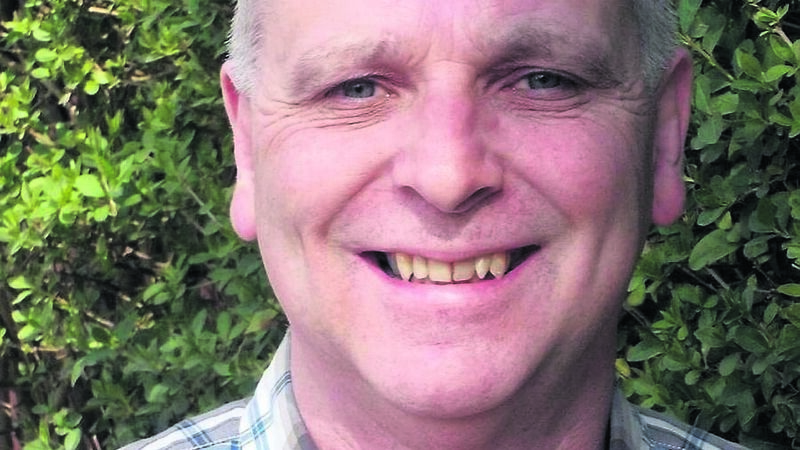A journey through time for the River Shannon

Author Paul Clements Shannon Country
- Shannon Country: A River Journey Through Time
- Paul Clements
- Lilliput Press, €15
IN prose every bit as mellifluous as his subject, Paul Clements presents a well researched, well-trodden and well-cycled study of the River Shannon. Of course he takes to the water to see castles, islands and callows to view the landscape from the river itself which gives a much different perspective. He explores Lough Ree and Lough Derg and Limerick where seaweed-strewn weirs were built by the Danes over 1,000 years’ ago.
“One moment it is satin, the next it produces a flickering ripple from a breeze as it winds imperceptibly on its slow meander.” This passage is not just a soothing style echoing the graceful movement of the river but it is informative to boot. In the next sentence Clements informs the reader the word meander is derived from the Menderes River in south-west Turkey.
Giving the book a structure is the journey in 1939 of writer, singer and film-maker Richard Hayward whose homage to the Shannon, Where the River Shannon Flows, is regarded as something of classic and references to which the writer continuously finds along the way: on a barge; in a pub; or in a casual conversation about the longest river in Ireland or Britain.
Not so much history as geography, not so much geography as architecture, the book is a paean not just to the people and places of the Shannon but the river itself. It is a story bound together by a rippling refrain, the search for Alcedo at this, the kingfisher, whose darting blue and orange form had eluded him over the years but whose signs and images he sees the length of the coursing river as if the bird itself had written ‘kingfisher was here’ on a sign and left it hanging on a gate.
The river begins at a small hollow in the ground in the northern reaches of Co Cavan at a place known as The Shannon Pot. Some claim its origins lie further north in Co Fermanagh and a network of underground streams funnelled through limestone passages feed the Pot and ultimately the Shannon itself. It drains a fifth of the entire island and 1,600 lakes, rivers and streams feed into it. It is a river prone to severe flooding (what river isn’t nowadays).
Witness, Carrick-on-Shannon and Athlone as chief litigants. However, the river has flooded for centuries, says Clements, before reminding us that flagrant construction on flood plains has been perhaps the chief instigator of many recent inundations.
Clements wends his way southwards through a succession of towns and villages some of which can hardly have changed much since Hayward’s time. The Upper Shannon has him negotiating Dowra at the northern part of Lough Allen to Drumshanbo at the south. Here he discovers a lively music scene and learns about the geography of the area whose glacial landscape is written through the dozens of expressions for the word ridge, namely ‘droim’: Drumshanbo; Drumderg; Drumgorman; Drumherrif, Drumkeelan; Drumbrisny and Drumboylan. His heart skips a beat at the mention of the Kingfisher Cycle Trail. He pushes on through the lively Carrick-on-Shannon where in the Bush Hotel framed sketches by Raymond Piper of the town hang on the walls. Piper was Hayward’s illustrator, so by now Clements well and truly has the scent of pursuit in his nostrils.
Onwards he goes through the Black Pig’s Dyke (an ancient border) and Rooskey, Kilbarry, Tarmonbarry and Lanesborough where he never fails to meet someone with an engaging story or two. Michael Casey is a woodcarver working mainly in bog oak and yew. His work has been purchased by Nelson Mandela, Yasser Arafat, Seamus Heaney and Paisley.
Next up is the vast Lough Ree at the start of the Middle Shannon, and which is divided between counties Roscommon, Longford and Westmeath. He engages a boatman to take him to the Black Islands on the lough and they again retrace Hayward’s footsteps where he spent some time visiting the Hanley family. Hayward said the family, long since gone, treated him like a king because of the hospitality his party received.
In Athlone he visits the bohemian left bank and of course a visit to Sean’s Bar which describes itself as the oldest pub in the world. Some statement, and probably true.

Onwards to Clonmacnoise and the historic abbey and compound which was a revered seat of learning in the Middle Ages. At a nearby B&B the proprietor solves the ‘bewildering topographical jigsaw’ he finds himself in. They are in ‘Offaly, west Offaly to be precise and looking into Roscommon, which is just over the bridge in Shannonbridge.
A short distance after that is Galway, over to the right of us is Westmeath, so we’ve four counties beside us, covering two provinces. Is that clear?” she asks. “Offaly is separated from its seven neighbouring counties by no fewer than 10 rivers.”
The Lower Shannon encompasses Portumna, Lough Derg and Holy Island, Killaloe, Ballina, Parteen Weir and Limerick, before 64km of estuary which includes Beagh Castle and Aughinish Island. He encounters Donal Boland who lives on a barge on the river at Killaloe and another fan of Hayward. He’s not shy about stating what is wrong with the river: “In Hayward’s time there was a linear community of river people. But it was a total community in the sense that all the people around the river had a relationship with the river and didn’t work in Dublin.”
The Shannon has had many incarnations and as many interpreters as people who have taken a boat on its surface. The shibboleth is ‘majestic’. It is also frequently referred to as ‘lordly’, ‘mighty’, ‘spacious’, noble’, ‘slumbering’ and ‘stately’. Perhaps the best term was that of the writer of the preface to Hayward’s book, the novelist Maurice Walsh, who called it ‘immense’. All of these terms are accurate at one time or another. To the Midland’s novelist John Broderick it had ‘a silent, menacing presence’. To James Joyce in The Dead it was the “dark mutinous Shannon waves”.
And mutinous is moot: there have been soundings from Dublin quarters of extracting water from the river to quench the insatiable thirst of that city. Unsurprisingly, not a popular idea on the Shannon.
Like all rivers, this one is a protean thing for Clements: “slow and ponderous, the Shannon is laden with memories, powerful in symbolism, prone to running rampant through fields and swamping houses, sometimes impeccably-well behaved and relaxed and other times tempestuously alive.” There are some omissions in the book whose inclusion would have helped form a more complete study. The author neglects to mention Bunratty Castle and its irresistible history and whose imposing presence lies but a few kilometres up the Ralty River. Several tributaries deserve a mention, not least the Suck and the Maigue, at least in passing, because their waters become the Shannon’s waters.
There have many great books on the history of rivers: Claudio Magris on the Danube; Wade Davis on the Amazon; Mark Twain on the Mississippi. Clements’s work may lack the greatness of these, which in fairness was bestowed over time, but at the very least it is a tributary to them.





